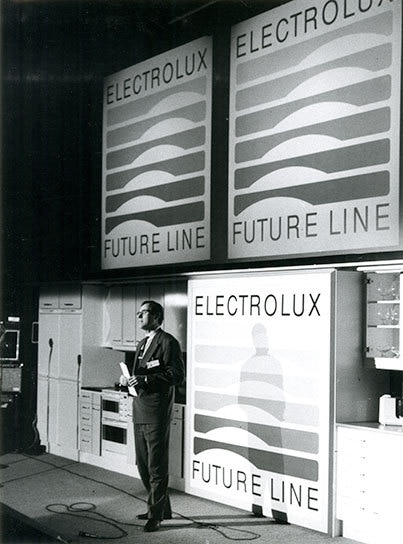In the 1950s consumers began to pay fresh attention to their kitchens. No longer a room that was off limits, it was now a space to enjoy and socialize with family and dinner guests while the food was being prepared. The overall combination of colours and shapes became more important. Glossy magazines, TV advertising and trade fairs created considerable interest in Electrolux products.

Electrolux Future Line on display at a conference
Electrolux were comparatively late onto the cooking market. The Assistent food processor, launched in 1940, had been a great success but it was the exception rather than the rule. However the purchase in 1962 of Elektro-Helios, which had been producing a range of kitchen products since 1919, provided many new possibilities, as did the new Design Department. The Future Line range, for example, was launched in 1968 and offered colours such as Poppy, Antique Gold, Avocado and Copper.
The Electrolux Kitchen as a concept was first presented at a trade fair in the late 1960s. Kitchen appliances were displayed in combination with products such as shelves, cupboards and kitchen sinks
Enormous opportunities for renovation
At this point, the company realized that in Sweden as a whole there were 1.8 million kitchens built before 1953 which would benefit from renovation. They were able to help by providing the customer with comprehensive measurements and drawings showing how the new kitchen would look. Electrolux would not only demolish the old kitchen, they could install the new one, offering sizes and colours according to individual taste.
What is more, from 1966 customers could get help from an “Electrolux Home Call”. A well-trained expert would visit and give advice on planning the kitchen and which products to choose. They could also help with getting a government loan to buy new white goods, a trend which became rather popular at this time.
New sales methods for new times
Sales methods were changing. Direct sales were diminishing in the 1970s and being replaced by specialist shops and department stores where the potential customers for kitchen products could browse around.
A large number of varied acquisitions of European competitors during the 1970s, 80s and 90s provided Electrolux with a far stronger market position in western and southern Europe. Belgian-French Arthur-Martin, Swedish Husqvarna, Italian Zanussi and German AEG Hausgeräte lived on as brands in their own right with their own individual kitchen concepts which appealed to local taste. The Group thus achieved a large market share while at the same time catering to their customers’ specific tastes.

